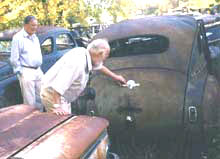In October 1999, two venerable automotive historians were pondering the upcoming execution of Plymouth, announced a month earlier in the motoring press. Mike, ever the romantic, remarked that Plymouth’s Mayflower badge still shone brightly, despite erosion of the car’s product line. Fred, the pragmatic realist, said it was all about bottom line, and some hokus-pokus called “brand management” that was sweeping the industry. Apparently Plymouth’s brand managers hadn’t managed very well.
Plymouth had come in on a rising tide. Introduced on July 7, 1928, it was a modern four-cylinder car, first in the low-price range with four-wheel hydraulic brakes. The PA model, new for 1931, brought style, further enriched by the PB of 1932. In 1933, Plymouth went to six-cylinder cars across the board. Over the years, Plymouth had a number of distinctive models, such as the only 7-passenger sedan of the Low Priced Three (this is a 1940), and the Suburban, the first all-steel station wagon of the Big Three manufacturers.
The 1953 and ’54 Plymouths are often considered “stubby,” but I find them well-proportioned. Virgil Exner’s Forward Look for 1955 vindicated Plymouth’s beauty, and the “Suddenly it’s 1960” styling of 1957 established Chrysler Corporation as a trend-setter. Plymouth lost third-place standing (to Rambler) in 1960 and ’61, and slipped further from 1962-69, but it remained Chrysler Corporation’s best-selling make. The compact Valiant (initially not badged as a Plymouth) was more distinctive than its Falcon or Corvair competition, and the glass-back Barracuda had no match in the industry. By 1970, Plymouth was back in third, but more storm clouds were brewing.
Simply put, for the next three decades Plymouth was on a starvation diet. From 16 models in 1970, Plymouth was down to three within a decade. With the exception of the street rod-inspired Prowler of 1997, Plymouth never again had a distinctive model. As time went on Plymouth had hardly any models at all, and when the cute little Neon said “Hi” in 1994 the only difference from Dodge was a glued-on emblem. The model even had to share its name with big brother. The corporate strategy became clear when the PT Cruiser was introduced in 1999 as a Chrysler. The car that should have been a Plymouth, because it looked like one, was kicked upstairs.
When the last Plymouth, a silver Neon, left the line in June 2001, Dodge became DaimlerChrysler’s price leader. Plymouth had not had its own division since 1961, and had never had a separate dealer network, so corporately there was little to lose. Still, there were unintended consequences. Most Mopar outlets in our area now sell Chrysler, Dodge and Jeep (and sometimes many, many more), but our closest Chrysler-Plymouth store happened to be next door to the Dodge dealer. With the loss of Plymouth, in order to keep the low-priced showroom traffic the Chrysler guy took on Kia. Apparently Kia has been a success, so much so that he’s ditched the Chrysler franchise. What hath brand management wrought?

